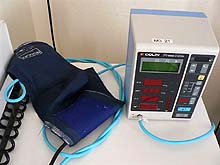What Is Blood Pressure?

Just what is says. Arteries and veins form a closed circuit (filled with blood) fitted with an in line pump, the heart. The heart contracts, forcing blood via the arteries to all parts of the body. Every surge of blood causes a palpable pulsation: the pulse.
Following every contraction, the heart relaxes. During contraction the pressure in the arteries reaches a peak. When measured, this is called the systolic pressure, also known as the upper value or reading. With the heart at rest, the pressure drops; but not to zero. This is called the diastolic or lower reading.
Blood pressure is measured by wrapping a cuff around the upper arm which is inflated until all flow is cut off. During slow deflation of the cuff one listens, by means of a stethoscope, waiting for the pulse to appear and later disappear, noting the readings at both instances. Pressure within the cuff is registered by either a mercury or aneroid baumanometer.
In a healthy young male these values would be 120 and 80 mm mercury respectively. Females usually have slightly lower readings.
|